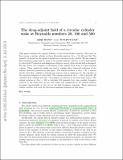| dc.contributor.author | Wang, Qiqi | |
| dc.contributor.author | Gao, Jun-Hui | |
| dc.date.accessioned | 2013-10-03T12:24:05Z | |
| dc.date.available | 2013-10-03T12:24:05Z | |
| dc.date.issued | 2013-07 | |
| dc.date.submitted | 2013-05 | |
| dc.identifier.issn | 0022-1120 | |
| dc.identifier.issn | 1469-7645 | |
| dc.identifier.uri | http://hdl.handle.net/1721.1/81279 | |
| dc.description | Author's final manuscript July 6, 2013 | en_US |
| dc.description.abstract | This paper analyses the adjoint solution of the Navier–Stokes equation. We focus on flow across a circular cylinder at three Reynolds numbers, Re[subscript D] = 20,100 and 500. The quantity of interest in the adjoint formulation is the drag on the cylinder. We use classical fluid mechanics approaches to analyse the adjoint solution, which is a vector field similar to a flow field. Production and dissipation of kinetic energy of the adjoint field is discussed. We also derive the evolution of circulation of the adjoint field along a closed material contour. These analytical results are used to explain three numerical solutions of the adjoint equations presented in this paper. The adjoint solution at Re[subscript D] = 20, a viscous steady state flow, exhibits a downstream suction and an upstream jet, the opposite of the expected behaviour of a flow field. The adjoint solution at Re[subscript D] = 100, a periodic two-dimensional unsteady flow, exhibits periodic, bean-shaped circulation in the near-wake region. The adjoint solution at Re[subscript D] = 500, a turbulent three-dimensional unsteady flow, has complex dynamics created by the shear layer in the near wake. The magnitude of the adjoint solution increases exponentially at the rate of the first Lyapunov exponent. These numerical results correlate well with the theoretical analysis presented in this paper. | en_US |
| dc.description.sponsorship | United States. Air Force Office of Scientific Research. Small Business Technology Transfer Program (Contract FA9550-12-C-0065) | en_US |
| dc.description.sponsorship | United States. National Aeronautics and Space Administration. Fundamental Aeronautics Program | en_US |
| dc.description.sponsorship | United States. Dept. of Energy. Predictive Science Academic Alliance Program (Stanford University) | en_US |
| dc.language.iso | en_US | |
| dc.publisher | Cambridge University Press | en_US |
| dc.relation.isversionof | http://dx.doi.org/10.1017/jfm.2013.323 | en_US |
| dc.rights | Creative Commons Attribution-Noncommercial-Share Alike 3.0 | en_US |
| dc.rights.uri | http://creativecommons.org/licenses/by-nc-sa/3.0/ | en_US |
| dc.source | arXiv | en_US |
| dc.title | The drag-adjoint field of a circular cylinder wake at Reynolds numbers 20, 100 and 500 | en_US |
| dc.type | Article | en_US |
| dc.identifier.citation | Wang, Qiqi, and Jun-Hui Gao. “The drag-adjoint field of a circular cylinder wake at Reynolds numbers 20, 100 and 500.” Journal of Fluid Mechanics 730 (September 30, 2013): 145-161. | en_US |
| dc.contributor.department | Massachusetts Institute of Technology. Department of Aeronautics and Astronautics | en_US |
| dc.contributor.mitauthor | Wang, Qiqi | en_US |
| dc.relation.journal | Journal of Fluid Mechanics | en_US |
| dc.eprint.version | Author's final manuscript | en_US |
| dc.type.uri | http://purl.org/eprint/type/JournalArticle | en_US |
| eprint.status | http://purl.org/eprint/status/PeerReviewed | en_US |
| dspace.orderedauthors | Wang, Qiqi; Gao, Jun-Hui | en_US |
| dc.identifier.orcid | https://orcid.org/0000-0001-9669-2563 | |
| mit.license | OPEN_ACCESS_POLICY | en_US |
| mit.metadata.status | Complete | |
